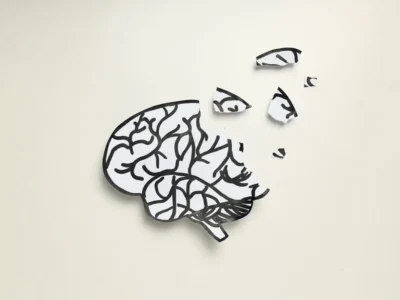Borderline personality disorder explained by Elena Serrano and her experience over the years with this illness.
Hello, my name is Elena, I am 36 years old and for 3 years I have lived with borderline personality disorder (BPD) and a chronic anxious-depressive condition. Although I was diagnosed about 3 and a half years ago, I do not know how long I have actually had BPD. Also, I began to experience anxiety at 16 and depression did not take long to arrive.
In this article I will talk in detail about borderline personality disorder and my experience over the years with this disorder, which, although socially misunderstood, is no less serious.
What is borderline personality disorder?
Borderline personality disorder is a serious mental illness characterized by unstable moods, behavior, and relationships.
Most people with borderline personality disorder suffer from:
- Problems regulating emotions and thoughts.
- Impulsive and reckless behavior.
- Unstable relationships with others.
People with this disorder also have high rates of comorbid conditions. For example, depression, anxiety disorders, substance abuse, and eating disorders. As well as self-harm, suicidal behaviors, or suicide.
Symptoms of BPD or borderline
Although I have already mentioned some symptoms present in this disorder, there is certainly a set of diagnostic criteria described by the DSM-5 (Diagnostic and Statistical Manual of Mental Disorders). This manual is a classification system for mental disorders that provides clear descriptions of diagnostic categories. Its objective is that clinicians and researchers in the health sciences can diagnose, study, exchange information, and treat various disorders.
This list includes 9 criteria; however, to be diagnosed with BPD one must meet at least 5 of these criteria:
- Frantic efforts to avoid real or imagined abandonment.
- A pattern of unstable and intense interpersonal relationships characterized by alternating between extremes of idealization and devaluation.
- Identity disturbance: markedly and persistently unstable self-image or sense of self.
- Impulsivity in at least 2 areas that are potentially self‑damaging (for example: spending, sex, substance abuse, reckless driving, binge eating).
- Recurrent suicidal behavior, gestures or threats, or self‑mutilating behavior.
- Affective instability due to marked reactivity of mood (for example: episodes of intense dysphoria, irritability, or anxiety that usually last a few hours and only rarely more than a few days).
- Chronic feelings of emptiness.
- Inappropriate, intense anger or difficulty controlling anger (for example: frequent displays of temper, constant anger, recurrent physical fights).
- Transient, stress‑related paranoid ideation or severe dissociative symptoms.
Causes of borderline personality disorder
In general terms, there are 2 interrelated factors that contribute to the development of personality. These factors are:
- Environmental factors, that is, a person’s life experiences, particularly early childhood experiences.
- Biological factors, that is, genetic makeup and temperament.
A person’s genetics and early life experiences interact in complex ways to influence the development of their personality and, subsequently, their vulnerability to developing personality disorders.
Childhood experiences
Numerous studies and clinical observations support the idea that childhood experiences play an important role in the development of personality traits and personality disorders.
Traumatic childhood experiences, such as physical, sexual, or emotional abuse and neglect, have been identified as risk factors that increase the likelihood of developing a personality disorder. But other adverse childhood experiences can also raise the risk of developing features of a personality disorder.
The following data have been taken from the Family Experiences in Childhood Scale (EFI, 2010):
- Feelings were not talked about openly.
- As a child no one noticed how I felt.
- Feeling insecure in childhood.
- Frequent shouting at home.
- There was hardly any laughter or fun at home.
- So many things happened at home that I tried to be invisible.
- Sensing that your concerns did not matter.
- No matter what I did it was never enough.
- Emotionally absent parents.
- A violent parent or caregiver.
- Lack of positive reinforcement.
- Being ridiculed (humiliated) by family when expressing an idea or emotion.
- Adults in the family told you about or involved you in their problems.
- Frequent insults like useless, stupid, lazy.
- Sexual abuse.
Attachment
There are also attachment types that I consider important to mention because they can also affect the emergence or not of personality disorders. Attachment types can be:
- Secure
- Insecure or avoidant
- Insecure or ambivalent
- Disorganized
Development of BPD
There is, therefore, dysregulation in adulthood resulting from the factors that influence a person, as we said, from early childhood, which translates into the following:
- If as children they did not learn to differentiate their own emotions from those of others, they will tend to continue doing the same as adults.
- People with attachment problems often reach conclusions about what others think and feel based on their own emotional state, repeating what they have learned (they respond the way their parents did when they were children).
- A person with insecure or disorganized attachment usually has great difficulty coping with problems effectively and tends to resort to impulsive action.
And the problem does not stop there; children who suffer any type of abuse tend to internalize the messages about how they were treated. For example, if patients were punished for expressing or feeling a certain emotion, they will tend to do the same as adults. Also, there are the typical phrases that many children had to hear and that Right Now they believe just because when they were children someone said them repeatedly:
- You are useless.
- No one cares about you.
- You are a failure.
- You shouldn’t have been born; you’re better off dead.
- You can’t trust anyone; everyone will hurt you.
- No one will love you if they really know you.
- You’re good for nothing.
Comorbidity with other disorders
Comorbidity is the occurrence of another clinically diagnosed illness that coexists with the primary illness. In this case it is borderline personality disorder.
Disorders, illnesses, or behaviors that are comorbid with BPD:
- Substance abuse.
- Affective disorders, such as bipolar disorder, major depression, and dysthymia.
- Eating disorders.
- Impulsivity problems. For example, disorders such as kleptomania, pyromania, impulsive buying, repetitive self‑harm, gambling addiction, nail‑biting (onychophagia) and trichotillomania (pulling out one’s own hair or body hair).
- ADHD.
- Psychosis.
- Anxiety disorders. These can include post‑traumatic stress disorder, learning disorders, social phobia, specific phobia, obsessive‑compulsive disorder, agoraphobia, and generalized anxiety disorder.
- Somatoform disorders.
- Dissociative disorders.
- Other personality disorders such as histrionic, narcissistic, antisocial, schizotypal, schizoid, paranoid, dependent, obsessive, and avoidant.
- Suicide.
As you can see, borderline personality disorder is a very complex disorder. This disorder can co-occur with other disorders or be confused with them, so careful evaluation of the patient and their symptoms is very important for an accurate diagnosis.
Treatments for BPD
Borderline is a disorder that has been discovered relatively recently thanks to advances in medical and psychological research. Today we have a wide variety of therapies that are very effective. Each of them is equally effective, each with its own way of treating, but that does not make any of them less valid.
Below, I list the treatments:
- Cognitive‑behavioral therapy.
- Dialectical behavior therapy (DBT).
- Acceptance and Commitment Therapy (ACT).
- Mindfulness.
My personal experience with borderline personality disorder

From my experience, as a person who suffers from borderline personality disorder I could say many things, since I have suffered from this disorder for a long time. The problem is that it was not diagnosed until relatively recently, and that has made my suffering greater.
To professionals, let’s say psychologists or psychiatrists, labels are not usually liked, but when you are suffering a series of symptoms (which I will explain below from my experience), I can assure you that knowing that what is happening to you has a name is very helpful and greatly relieves. This does not by any means solve the problem, as it will not cure you. However, it is like taking a weight off your shoulders.
My diagnosis
As I said before, of the nine criteria, you must have at least five to be diagnosed with BPD, and I have practically all nine. In addition, I am diagnosed with a chronic anxious‑depressive condition.
First, I have experienced all the risk factors that increase the likelihood of developing BPD since childhood. The adverse experiences, the comments I received for saying something I thought, felt, or did. I have lived all of that firsthand. That’s what it means to have had a dysfunctional family.
Regarding the diagnostic criteria for BPD that were listed in the 9 points above, what I can note about my symptoms are:
- Self‑injuries with cuts and suicide attempts.
- Impulses through binge eating, shopping, and reckless driving.
- Problems with my emotions. For example, feelings of emptiness and extreme mood swings (one day I adore you, and if you do or say anything I don’t like or consider inappropriate, I hate you).
- Completely unstable interpersonal relationships. In this area I do not relate to anyone, I have no friends, I don’t go out.
- Real or imagined abandonment, which for me is undoubtedly real, hence my poor interpersonal relationships or the sudden hatred of people. If I meet someone, something I always do through social networks, I end up pushing them away and removing them from my life with my behavior, mistreating those people.
Childhood
Time to talk about my childhood? Yes, I admit it, my childhood was totally dysfunctional. My father was an alcoholic and abusive. Besides being afraid of him, I felt abandoned by him. He wouldn’t let me have friends, go out, or have any kind of relationship with girls my age. My mother also ignored me and I felt abandoned by her as well. I experienced all the childhood risk factors that increase the likelihood of developing BPD. The ones I loved most and who were always there were my brother and my grandparents. There is no one left now, not even my brother.
The anxiety, which is chronic, lives with me permanently. Does anyone have any idea what it is like to live with anxiety 24 hours a day, 365 days a year for 20 years?
Medication and treatment
I suppose the medication will have its effect. I imagine that if I didn’t take it I would be worse. But I tell my psychiatrist and I see that he doesn’t understand me. I talk to a private psychologist and I always get angry because I also feel that she doesn’t understand me. The problem is that they think, or well, my psychologist thinks, that by doing this and that, the anxiety and the rest of the symptoms will calm down. It is known that BPD has no cure, but it is possible to achieve a reduction of symptoms and have a totally normal life. I can understand that in a “normal” BPD case, what I don’t understand is that I have had so many years of so much pain and so much fear and so much anxiety and so much resentment and so much of everything, that sometimes I think I am a lost cause.
Conclusion
To conclude, the only thing I can say is that my life, for as long as I can remember, has been a hell. If I think about my childhood, I only remember physical and psychological abuse, fear and abandonment; as I grew, I remember more abuse, more fear and more abandonment and we add bonds. In adolescence, I remember anxiety, bonds and abandonments. Adulthood, up to 22 years old, I remember bonds, anxiety, pain, rage toward others and toward myself. That rage began in childhood and has grown with me. Today it continues by my side and I don’t think it will ever go away. And the rest of my adulthood, I remember abandonment, pain and rage, and anxiety of course, that started at 16 years old as I have already mentioned.
And this is my life.
If you liked this post about borderline personality disorder told in the first person, we recommend you take a look at these posts:
“This article has been translated. Link to the original article in Spanish:”
El trastorno límite de personalidad contado en primera persona







 Differences Between Multiple Sclerosis and Amyotrophic Lateral Sclerosis and the Impact of the 2024 ALS Law
Differences Between Multiple Sclerosis and Amyotrophic Lateral Sclerosis and the Impact of the 2024 ALS Law
Leave a Reply